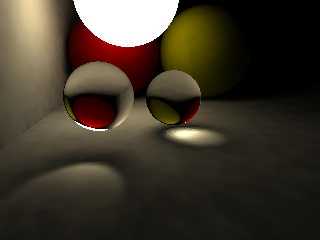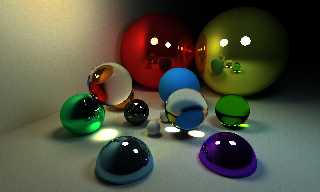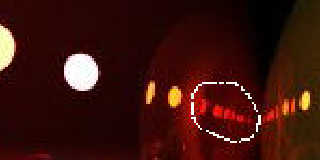 |
 |
|
 |
|
 |
|  |
|  |
|
 |
|
 |
|  |
|  |
|
 |
you're using photon mapping for the caustics, right? Ever since these
guys have been posting these bruteforce renders, I've been noticing an
interesting pattern about photon mapping: the caustics don't match the
shape of the source of light, you look at your render and to that of
Severi and you notice your caustics are focused in one point while his
are large and in the shape of the light sphere. And that is to be
expected, since photon mapping reacts to the (point)light source, not to
a physical object emitting light, like in the bruteforce methods.
But radiosity works ok for that purpose. Like here, just first
radiosity pass as I don't have the time right now for a complete
render... there are a few radiosity artifacts left, you could raise the
count a bit...
#local GIgather = 1;
#default { pigment { rgb 1 } finish { ambient 0 diffuse .5 } }
global_settings {
adc_bailout .02
radiosity {
brightness 1.8
gray_threshold .3
error_bound .1
low_error_factor .5
#if (GIgather)
save_file "pde.rad"
count 80*4
recursion_limit 3
always_sample no
nearest_count 16
pretrace_end .006
#else
load_file "pde.rad"
count 1
recursion_limit 1
always_sample no
nearest_count 1
pretrace_end 1
pretrace_start 1
#end
}
}
#macro refl()
#if (!GIgather)
reflection 1
#end
#end
union {
plane { y, 0 }
plane { x, -2 }
// light ball
sphere { y*2-x/2, .8 pigment { rgb <1,.9,.6> } finish { ambient 3
diffuse 1 }}
// back balls
sphere { <-1,1,2>, 1 pigment { rgb x } finish { diffuse 1/3 refl()
metallic .5 }}
sphere { <1,1,2>, 1 pigment { rgb x+y } finish { diffuse 1/3 refl() }}
// glass ball
sphere { <.2,.5,-.6>, .4 pigment { rgbt 1 } finish { diffuse 0 } hollow
interior {ior 1.33}}
sphere { <-.7,.7,-1.5>, .4 pigment { rgbt 1 } finish { diffuse 0 }
hollow interior {ior 1.33}}
}
camera {
location <0,1.4,-5>
look_at 0
angle 55
#if (!GIgather)
aperture .01 blur_samples 40*6 variance .0000001 confidence .99
#end
}
Post a reply to this message
Attachments:
Download 'pretty_damn_easy.jpg' (16 KB)
Preview of image 'pretty_damn_easy.jpg'

|
 |
|  |
|  |
|
 |
|
 |
|  |
|  |
|
 |
Tim Attwood wrote:
>> Could you try also with radiosity? Now your test image lacks global
>> illumination which contributes a lot to realism. Also the shadows seem
>> to be way too sharp considering the size of the emitting ball.
>
> Here's one with a little bit better radiosity... high quality settings
> take a lot of time, these are medium settings. (26m)
Better but still there is something that is missing. I don't know. Maybe
it is the small color bleeding/caustics that make images either look
realistic or not. I attached a higher quality render of similar scene.
Noise is better and when scaled down it looks very smooth.
Of course my scene has spheres with more reflection and less diffuse
light overall. My scene has darker shadows. Your blue and white balls
have very different diffuse characteristics. Etc. Not really comparing
just apples. If I have time, I try to install POV to my Linux side and
try myself to replicate this scene.
Actually the whole thing of what constitutes a realistic looking image
is quite fascinating. There are definitely many things that are hard to
pin-point but which still makes use realize we are looking at GC image.
For my eyes it looks like brute force renderers (or any renderer that
shoots MANY rays and let them bounce) cover many of those things.
>> I also noticed caustics that can be seen below the green refractive
>> sphere. They came from reflections from the big yellow sphere. I guess
>> in POV you have to tell POV where to shoot photons? So you might also
>> miss these kind of effects?
>
> Depends on what you mean by miss... you have control in POV to
> omit them if you want to. It's a different way of doing it.
Sadly it is more often the opposite, IMO. Images lack many features that
really should be there. We see images with no global illumination, no
caustics, no realistic shadows based on light source shape etc. So many
times I have seen an image which looks kinda "POVish". And then I see
something stunning which more than often meant that it was made with
another renderer. Again, I'm not necessarily saying that it can't be
done with POV, but it seems to be very difficult because you have to
enable and tweak all imaginable effects separately and use many "hacks".
> It's easy to miss the artifacts in any good image... for example where
> your red and yellow spheres have a bit of hall-of-mirrors the color
> fading into the distance is uneven, which is caused by the unbiased
> methods, but would eventually resolve. Or the sharp edges on the
> highlights seems a bit harsh, sort of like unintentional lens flares...
> another artifact that your mind subconsciously ignores.
I don't know what you mean by uneven fading. Is it still present in this
higher quality render attached? The sharp highlights are result of the
way the image is generated. I consider anything above 1.0 pure white. So
if I have a VERY bright lightsource, then the "perfectly antialiased"
value is still way above 1.0 and we see rough edges. As you can see,
some spheres have smooth highlight and some rough. At this point this is
intentional but might change.
Post a reply to this message
Attachments:
Download 'kuva9.jpg' (76 KB)
Preview of image 'kuva9.jpg'

|
 |
|  |
|  |
|
 |
|
 |
|  |
|  |
|
 |
nemesis wrote:
> you're using photon mapping for the caustics, right? Ever since these
> guys have been posting these bruteforce renders, I've been noticing an
> interesting pattern about photon mapping: the caustics don't match the
> shape of the source of light, you look at your render and to that of
> Severi and you notice your caustics are focused in one point while his
> are large and in the shape of the light sphere. And that is to be
> expected, since photon mapping reacts to the (point)light source, not to
> a physical object emitting light, like in the bruteforce methods.
>
> But radiosity works ok for that purpose.
But radiosity doesn't work very well for shadows. AFAIK it is not that
easy to get sharp shadows with radiosity, where needed. As we saw in the
thread "Motecarlo path tracing with MegaPov 1.2.1". So you still have to
combine the usage of conventional light sources and emitting
shapes+radiosity.
So basically the user has to constantly make decisions like: "Do I want
semi-accurate shadows (only from certain light-source shapes, though),
or do I want semi-accurate caustics with radiosity artifacts? Or should
I try to use both to get decent results?"
Post a reply to this message
|
 |
|  |
|  |
|
 |
|
 |
|  |
|  |
|
 |
Severi Salminen wrote:
> Do you know if
> "normal" reflections happen (about) equally when going from less dense
> medium to denser medium when compared to opposite situation?
Sorry, I'm not too acquainted with the specifics of the physics
involved...
> And my renderer
> still misses many important features that make the image look realistic.
Speaking of which, does it handle total internal reflection properly?
(OTOH, that would also be something which should be specified with a
physically accurate BRDF instead of being hard-coded into the renderer...)
Post a reply to this message
|
 |
|  |
|  |
|
 |
|
 |
|  |
|  |
|
 |
> Do you know if
> "normal" reflections happen (about) equally when going from less dense
> medium to denser medium when compared to opposite situation?
Yes, the inside of a RL glass surface reflects about the same as
the outside, sometimes a bit more reflective, since grime can
build up on the outside, but not on the inside.
Post a reply to this message
|
 |
|  |
|  |
|
 |
|
 |
|  |
|  |
|
 |
> I don't know what you mean by uneven fading. Is it still present in this
> higher quality render attached?
Yes, the first couple reflective bounces are colored darker,
(which is correct) but as the reflections continue on they
are close to the same color instead of darker, probably a
saturation issue?
Post a reply to this message
Attachments:
Download 'kuva9a.jpg' (15 KB)
Preview of image 'kuva9a.jpg'

|
 |
|  |
|  |
|
 |
|
 |
|  |
|  |
|
 |
"Tim Attwood" <tim### [at] comcast net> wrote in message
news:47c34a7b$1@news.povray.org...
>> Do you know if
>> "normal" reflections happen (about) equally when going from less dense
>> medium to denser medium when compared to opposite situation?
>
> Yes, the inside of a RL glass surface reflects about the same as
> the outside, sometimes a bit more reflective, since grime can
> build up on the outside, but not on the inside.
Are you sure? A watersurface seems a lot more reflective from underneath
the water than from above the water. Could be an optical illusion though.
cu!
--
#macro G(b,e)b+(e-b)*C/50#end#macro _(b,e,k,l)#local C=0;#while(C<50)
sphere{G(b,e)+3*z.1pigment{rgb G(k,l)}finish{ambient 1}}#local C=C+1;
#end#end _(y-x,y,x,x+y)_(y,-x-y,x+y,y)_(-x-y,-y,y,y+z)_(-y,y,y+z,x+y)
_(0x+y.5+y/2x)_(0x-y.5+y/2x) // ZK http://www.povplace.com net> wrote in message
news:47c34a7b$1@news.povray.org...
>> Do you know if
>> "normal" reflections happen (about) equally when going from less dense
>> medium to denser medium when compared to opposite situation?
>
> Yes, the inside of a RL glass surface reflects about the same as
> the outside, sometimes a bit more reflective, since grime can
> build up on the outside, but not on the inside.
Are you sure? A watersurface seems a lot more reflective from underneath
the water than from above the water. Could be an optical illusion though.
cu!
--
#macro G(b,e)b+(e-b)*C/50#end#macro _(b,e,k,l)#local C=0;#while(C<50)
sphere{G(b,e)+3*z.1pigment{rgb G(k,l)}finish{ambient 1}}#local C=C+1;
#end#end _(y-x,y,x,x+y)_(y,-x-y,x+y,y)_(-x-y,-y,y,y+z)_(-y,y,y+z,x+y)
_(0x+y.5+y/2x)_(0x-y.5+y/2x) // ZK http://www.povplace.com
Post a reply to this message
|
 |
|  |
|  |
|
 |
|
 |
|  |
|  |
|
 |
> Are you sure? A watersurface seems a lot more reflective from underneath
> the water than from above the water. Could be an optical illusion though.
Look up some lake reflections... it's just that sometimes the
surface of water doesn't have much to reflect, just empty sky.
Post a reply to this message
|
 |
|  |
|  |
|
 |
|
 |
|  |
|  |
|
 |
Tim Attwood wrote:
>> I don't know what you mean by uneven fading. Is it still present in this
>> higher quality render attached?
>
> Yes, the first couple reflective bounces are colored darker,
> (which is correct) but as the reflections continue on they
> are close to the same color instead of darker, probably a
> saturation issue?
Yeah, it is simply because the spheres are very reflective and the light
source is very intensive. So the red components remains strong even
after many bounces. It takes many reflections to get the value go down.
I tested with dimmer lights and a bit less reflective surface and it
works as it should: it gets darker every time it reflects.
Post a reply to this message
|
 |
|  |
|  |
|
 |
|
 |
|  |
|  |
|
 |
Warp wrote:
> Speaking of which, does it handle total internal reflection properly?
Yeah, I think it does. But I don't have proper objects to test it
properly so I'm not 100% sure yet. I tried to place camera inside a
glass sphere and I did saw internal reflection (basically you see a
circular "window" and the outside is dark).
> (OTOH, that would also be something which should be specified with a
> physically accurate BRDF instead of being hard-coded into the renderer...)
I have no idea how to represent an arbitary BRDF or BSDF. But you get
quite far even with traditional refraction/specular/diffuse models.
Post a reply to this message
|
 |
|  |
|  |
|
 |
|
 |
|  |
|
 |




![]()